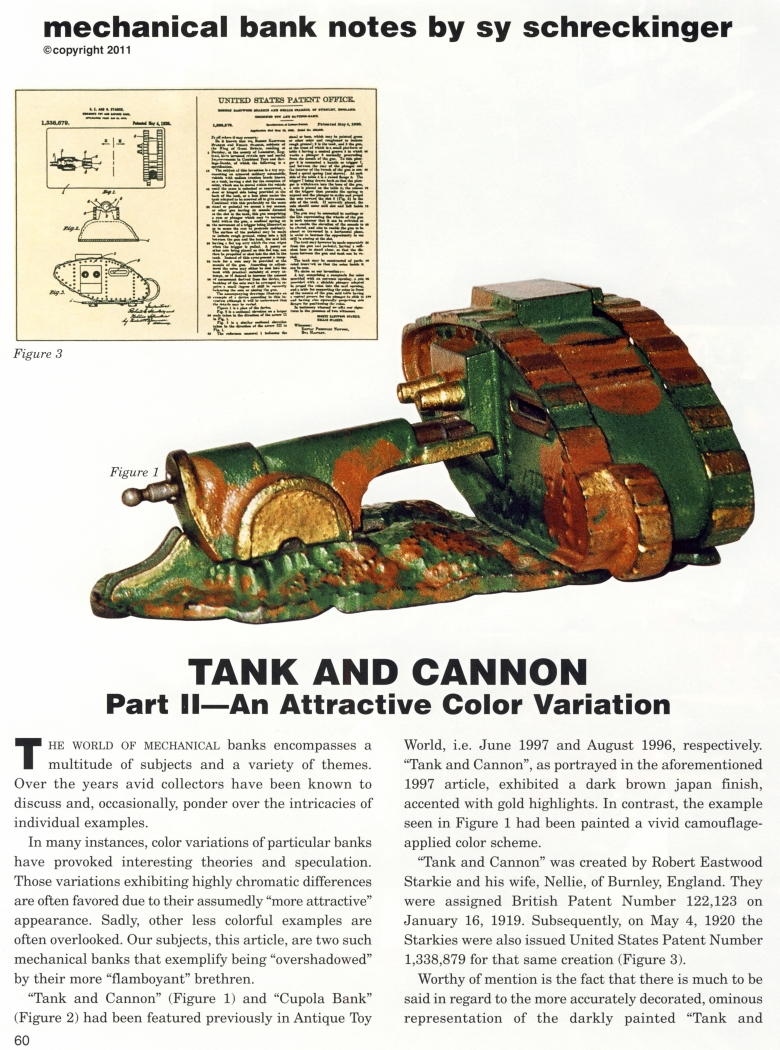|
Tank and Cannon
Part II — An Attractive Color Variation
by Sy Schreckinger – ANTIQUE TOY WORLD Magazine – September, 2011
Cupola Bank
Part II — An Attractive Color Variation
THE WORLD OF MECHANICAL banks encompasses a multitude of subjects and a
variety of themes.
Over the years avid collectors have been known to discuss and,
occasionally, ponder over the intricacies of individual examples.
In many instances, color variations of particular banks have provoked
interesting theories and speculation. Those variations exhibiting highly
chromatic differences are often favored due to their assumedly "more
attractive" appearance. Sadly, other less colorful examples are often
overlooked. Our subjects, this article, are two such mechanical banks
that exemplify being "overshadowed" by their more "flamboyant" brethren.
"Tank and Cannon" (Figure 1) and "Cupola Bank" (Figure 2) had been
featured previously in Antique Toy
World, i.e. June 1997 and August 1996, respectively. "Tank and Cannon",
as portrayed in the aforementioned 1997 article, exhibited a dark brown
japan finish, accented with gold highlights. In contrast, the example
seen in Figure 1 had been painted a vivid camouflage-applied color
scheme.
"Tank and Cannon" was created by Robert Eastwood Starkie and his wife,
Nellie, of Burnley, England. They were assigned British Patent Number
122,123 on January 16, 1919. Subsequently, on May 4, 1920 the Starkies
were also issued United States Patent Number 1,338,879 for that same
creation (Figure 3).
Worthy of mention is the fact that there is much to be said in regard to
the more accurately decorated, ominous representation of the darkly
painted "Tank and
Cannon" mechanical featured in my previous article. The tank was
purposefully designed and gloomily painted by the British military to
evoke fear and panic within the ranks of the German infantry during
World War I.
"Cupola Bank" (Figure 2) is another example of an extremely desirable
mechanical that was typically painted at the factory, utilizing a
monochromatic coloration. A plethora of examples exhibit either an
overall pink, beige, light blue or dark brown pigmentation. The bright
multicolored examples, as pictured in Figure 2, are rarely seen.
However, because of their highly attractive appearance, when offered for
sale, generally command a premium price. Nonetheless, those austerely
painted examples, when located in superb, near mint condition, maintain
a simplistic, albeit elegant demeanor, and certainly worthy of
possessing.
"Cupola Bank" was designed by Mr. Deidrich Dieckmann of New York City.
He was granted Patent Number 146,755 on January 27, 1874 for his
invention (Figure 4). Dieckmann's uniquely styled architectural bank was
subsequently manufactured by the J. and E. Stevens Company of Cromwell,
Connecticut.
To conclude, both subjects featured in this current article are highly
desirable and extremely scarce. Hopefully, collectors in earnest pursuit
of the more "colorful" variations do not overlook the design, brilliance
and concept of the mechanical bank itself.
Acknowledgment: The superb, camouflage example "Tank and Cannon" Bank
(Figure 1) is in the collection of Bob Weiss.
|


